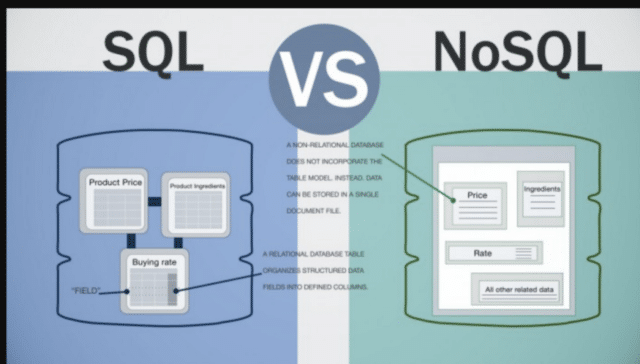As cloud computing technology continues to evolve, cloud services are becoming the norm. Most organisations are employing cloud platform services such as Amazon Web Services (AWS) or Microsoft Azure. Enterprises want better value, flexibility, and agility. There are diverse cloud database options to fit their needs. And it is now easy for enterprises to move to a cloud database provider.
There are different types of cloud database services, and many ways to implement them. Each organisation will need to define its needs before it can select the right model.
Types of cloud databases
A cloud database service is easy to use and can provide many benefits. But different types of cloud databases offer different solutions. Information stored on the cloud can be structured or unstructured.
How cloud databases work

A Relational Database Service (RDS) is one written in structured query language (SQL). SQL implements a set of interrelated tables that are organised into rows and columns which interact. This data interaction is governed by a schema. This means that relational SQL databases rely on data in a consistent format. Some examples of relational database services include MySQL (open source), Oracle, IBM DB2, and Microsoft Azure SQL Server.
Non-relational databases are unstructured and do not employ a table model. They are sometimes known as NoSQL. Unstructured, conceptual data formats like photos and videos are highly compatible with NoSQL databases. An example of a NoSQL database would be MongoDB which uses JSON-like documents with optional schemas.
Traditional cloud database
A traditional cloud database service runs similarly to an on-premises database. The data management is handled in-house. An IT team manages in-house infrastructure. The database is deployed and run on virtual machines in data centres (data centers, depending on their geographic location).
The responsibility, oversight, and maintenance falls to the organisation using the database. This does allow for more organisational control of database configurations. Oftentimes, a DevOps model is implemented in place of traditional IT staff.
Database as a Service (DBaaS)

DBaaS is becoming an increasingly used database solution. Organisations using DBaaS do not require any on-premises infrastructure or in-house database administrators. And DBaaS vendors can provide a fully managed database. It requires almost no investment and normally offers pay-per-use pricing.
DBaaS reduces in-house labour requirements by making use of automation and machine learning in multiple data stores. Cloud-native API integrations allow organisations to consolidate databases and use only one app. Things like maintenance and security can all be handled in real-time and autonomously. This makes DBaaS easy to use and cost-effective.
Benefits of cloud databases
Not every cloud database service offers the same benefits. However, cloud databases should offer the same behaviour to end-users as would an on-premises SQL database. Typical benefits of cloud database infrastructure include:
Ease of access
Cloud databases are available to the end-user via the internet, with the user connected to the relevant geographic data center. This means the user can expect high availability with maximal SLA compliance.
Cloud deployment of database resources is quick and easy. And databases can be removed if necessary. This flexibility means cloud databases are great for validating, testing, and building. And it is quite simple to terminate a project when necessary.
Operation speed
With a cloud database service, users connect to the closest data center. Cloud computing resources are provisioned in real-time for high performance. Real-time scalability handles peak loads seamlessly and maintains optimal performance to compute mission-critical operations.
Cloud databases give organisations maximum agility to deal with changes to business demands. Increased user workloads can be almost instantaneously scaled up to handle peak times. Enterprises experiencing rapid growth, meanwhile, will be able to scale operations in a timely and effective manner.
Risk reduction
With multiple data centers, enterprises using cloud databases reduce risk through redundancy. Databases are backed up and duplicated throughout a cloud provider’s network. But failover is also optimised, with a seamless switch over and no noticeable downtime or performance issues for the end-user.
Cloud providers handle all cybersecurity. This includes the use of machine learning and AI automation to thwart potential threats proactively. Cloud automation takes care of backups, replication, storage, and deployment.
Cost-effectiveness

Cloud databases are normally fee-based via a subscription and pay-per-use pricing plan. Provisioning of resources ensures organisations only use what they need. Many services may only be required temporarily or during peak workloads. With cloud database models, enterprises can simply switch unnecessary services on and off as needed.
DBaaS automation eliminates the prohibitive costs of in-house infrastructure. But it also eliminates or reduces the workload on database administrators. Oversight tasks like maintenance and management are handled by cloud service automation.
What to consider when choosing a cloud-based database
Cloud computing technology is evolving at an accelerated rate. A diverse array of providers offer cloud database solutions. But no one provider excels in all areas. Each organisation will need to determine and prioritise its needs to find a cloud database solution that is the right fit for the business.
Control options
Several DBaaS providers give minimal control to the organisation. Others offer a configurable database management system. For many enterprises, this is exactly what they want. A provider to control everything except the actual data itself.
However, many organisations will need to maintain control. Some organisations need controlled accessibility. Others, like those in healthcare, have specific needs to meet regulation and SLA compliance. Some organisations will need more control over provisioning and scalability to keep a tight rope on costs. Those organisations will want to look to multi-cloud or hybrid cloud providers as a solution.
Database technology
All organisations will expect uninterrupted data availability. However, during certain periods—like times of maintenance—there will be downtime. Big data may require cloud database services to be compatible with existing APIs and legacy systems.
The Google Cloud platform can manage open source databases like MySQL and PostgreSQL. Data migration with legacy systems can depend on each cloud provider.
For organisations where mission-critical applications cannot have any downtime, they can find a solution through the automation of DBaaS for failover. Another option is to combine an on-premises database with the cloud database in a hybrid model.
Security

Every enterprise will want a cloud solution that can handle real-time and at-rest data store encryption. And all cloud merchants will provide automatic cybersecurity updates.
But some areas for users to consider are how important data-redaction capability is for them. The highest cybersecurity comes with automated machine learning. In some instances, an organisation requires that mission-critical information be stored on-premises. Enterprises will need to know ahead of time if the security options they require can be met by each vendor.
Maintenance
Businesses or bodies that opt for more control will normally be using a traditional cloud database model. For these organisations, they are responsible for all maintenance. The onus is on in-house IT infrastructure to meet their evolving business needs. However, most enterprises will be looking to shift maintenance to the cloud provider.
DBaaS providers offer different tools and options for database management. Some may or may not be compatible with existing APIs that an enterprise is already implementing. Some organisations will need compatibility with open source databases like PostgreSQL.
Other companies will be looking to reduce IT workloads with full autonomous cloud databases. Level of control and workload will determine an organisation’s cloud database needs.
Conclusion
Any enterprise aiming for a complete digital transformation will need to plan for adoption of a cloud database. A technology adoption that will offer them improved flexibility and agility, but also help them reduce risk and operational costs.
There is no one-size-fits-all solution. Each organisation will need to formulate a plan first. Only then can a cloud database service provider be found that meets its needs.
What are the cloud database services you can integrate with RingCentral?

At RingCentral, we offer our cloud solutions to fit your organisation’s needs. With our UCaaS cloud communications solution, gain the flexibility to work from anywhere.
Integrate with your enterprise’s existing cloud infrastructure to optimise operations. RingCentral Office can integrate with and boost your pre-existing cloud infrastructure. A few examples of cloud database platforms our service can enhance are:
Oracle Sales Cloud
RingCentral provides integrated enterprise-grade communications seamlessly. There is no software or hardware to install, maintain, or upgrade. The service is ready to deploy on day one.
Sales agents save time by using only one app to access the CRM database and make sales calls. And they can work from anywhere as long as they have access to a web browser, regardless of the operating system.
Caspio Cloud Database
Thanks to Zapier, RingCentral Office can link up with Caspio Cloud Databases in minutes. No line of code is required! Caspio provides highly customisable automation for your call centre. Once integrated, database interactions can trigger call centre actions. Such as editing a database record generating an outbound call.
Five CRM
Five CRM can handle everything from account management, to call centre and email marketing. Five CRM enables organisations to use a cloud database platform with their call centre.
Five CRM also offers the ability to create up to 999 databases, all managed within one system. This allows for analysis and reports to work across databases in one data warehouse.
Access the database from the phone, RingCentral mobile app, or RingCentral desktop app. All it takes is two simple steps to get FIVE CRM’s RingCentral integration.
These are three examples of how RingCentral can integrate with your cloud database platform. And it’s really easy. No expertise is required to get your integration up and running in minutes. Gain flexibility and save time by using one app for CRM access and all call agent communications.
Originally published Feb 09, 2021, updated May 15, 2021

